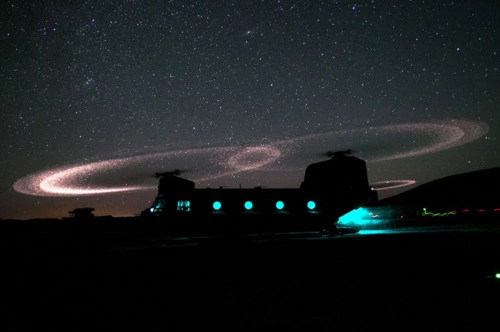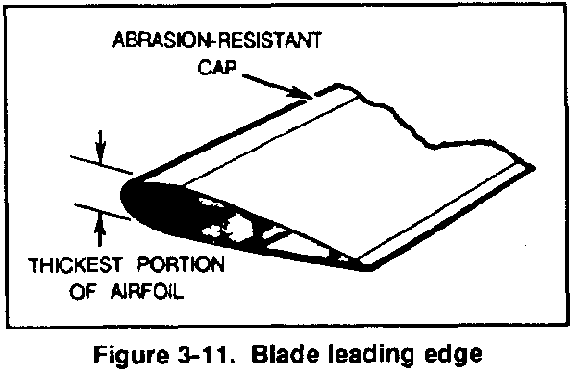
Descending into a drab, unnamed war zone, the helicopter is familiar sight. As it kicks up dust and sand, the onlooking soldiers barely shield their eyes; even their most sensitive organs are grizzled. The moonlight is occluded by the grainy mist.
The casual cargo drop is then enchanted by a peculiar sight: a glowing halo adorning the helicopter’s blades. Cutting through the sand and dust, the blades smash into millions of tiny particles, each creating their own nano-crater, each contributing to the halo.

I like to think that the seemingly spontaneous halo illuminates the otherwise dreary LZ. I like to think that perhaps, just for a second, a soldier forgets his or her dire mission and revels in the unexpected pleasure of curious physics. I like to think that one can find just a little beauty in battle: the Kopp-Etchells Effect.
The Science
When a helicopter descends into a sandy environment, the enormous downward thrust from the rotors inevitably kicks up a cloud of sand. Once in the air, the helicopter’s blades cut through this cloud, generating the halo.
But how? To prevent early degradation, most helicopter blades are coated with an abrasion strip. This strip, typically crafted out of a metal like titanium or nickel, prevents the leading edge of the rotor blade from being worn down too quickly by the various particulate hazards of the atmosphere.

This abrasion strip can handle a lot of wear and tear, but the desert is a harsh environment. Sand is harder than the titanium and nickel that make up the abrasion strip, so when the blades begin cutting through a cloud of sand, the particles hit the blades and send bits of metal flying into the air.
The Kopp-Etchells effect was first documented during combat operations in Afghanistan. The photographer Michael Yon named the effect after two soldiers who died there, Koop, a US Ranger, and Etchells, a British soldier. Both were killed in combat in this province of Afghanistan.

It turns out that the metals that make up the abrasion strips on helicopter blades, bracing themselves against the stinging force of the sand, can be pyrophoric. This means that the metals used are substances that can spontaneously ignite in air. But of course this doesn’t happen in normal circumstances; we don’t see bricks of titanium bursting into flames. Rather, the spinning blades of the helicopter generate a cloud of metal particles, just like the cloud of sand. Once in a powdered form, the metal particles can ignite and create the brilliant scenes above.
This may sound far-fetched, metals don’t just combust on their own? Right? Interestingly, we are all familiar with the pyrophoricity of metals, even if we don’t know it. Think of a metal that when struck creates a spark. The sparks that we see (maybe a dilapidated car is dragging a sparking muffler along the road) are in fact small metal particles being dispersed into the air by some impact and then igniting. And if you have ever started a fire with a flint, it’s just a simple MythBusters-esq ramping-up to imagine how the rotors of a helicopter spawn a shower of sparks.
I’d like to think that, with a tired face partially illuminated by the unnatural yet natural light emanating from the rotors, a soldier can for a moment escape from a solemn world to one filled with wonder. The astounded children watching the lab demonstration and the soldier are fleetingly connected.

Leave a Reply